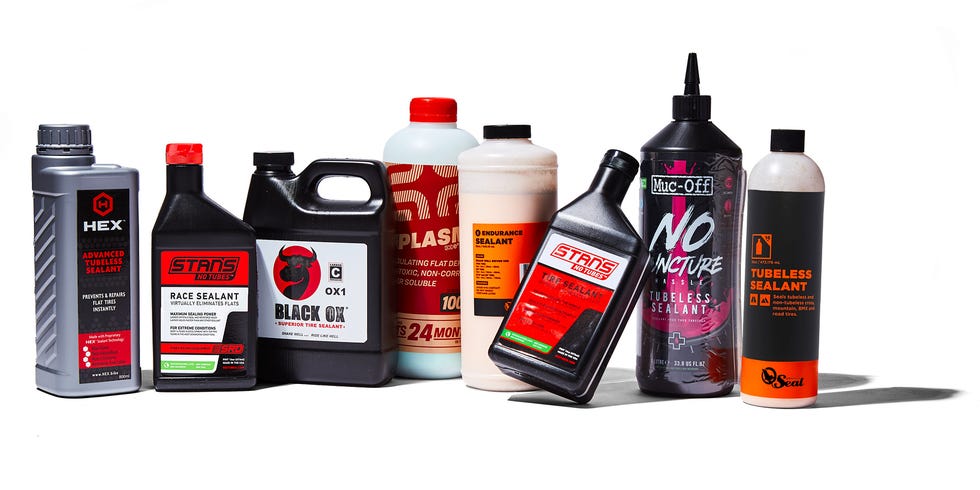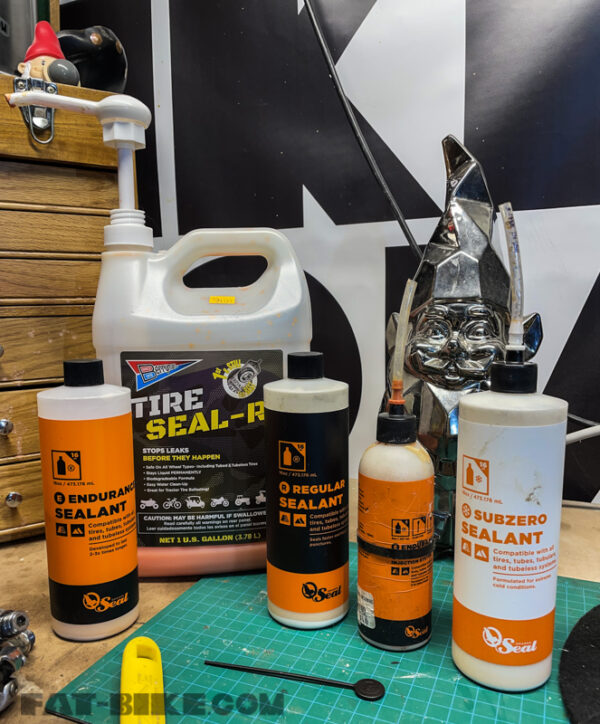A short story about tire sealant
The average fat biker that has one bike to maintain, probably can’t relate to our tubeless tire atmosphere, so I’ll try to preface this story with a little bit of information about our thirsty, tubeless tire situation. Companies ship us demo bikes to field test and they rarely come to us set up as tubeless. I value the way that a good tubeless setup makes a fat bike roll enough, that I usually convert the demo bike to tubelessness. For fresh tubeless setups, I add 6 ounces of sealant per tire. Even if a demo bike comes to us set up tubeless, many times the original tires that come with the bike do not match the current local trail conditions. Most complete bikes come in with the biggest tires that’ll fit on the bike and I don’t think that we’ve ever gotten a demo bike in with studded tires. This past winter, I was juggling three test bikes, plus my own bike, ten beers. If you do the math for four bikes times two tires times 6 ounces of sealant you get the main reason that I started to look for a less expensive alternative to bike shop brand sealant. We were going through a lot of sealant and we were paying for this stuff out of a meager operating budget.
On a trip to one of the mini farm fleet tractor supply chains near me, I decided to try Berryman tire sealant. The cost per ounce was significantly less than Stan’s or Orange Seal. Just to clear the air…the purpose of the story is not to get you to change to one brand sealant or another. I often joke that if you want to spark a lively conversation with your cycling friends, just ask them to try a new chain lube. Most mountain bikers will defend their lube of choice to the death and I think that the same thing is true about tubeless tire sealants I always felt that people should use whatever they want. I was never really picky about what brand sealant that I ran. I would try whatever brand sealant that was sent to us for testing or whatever brand sealant that was available at the bike shop that I was working for at the time. They all seem to work in a similar fashion with one notable exception. Café Latex sent us some of their sealant and it straight up failed. They later told us that they had sent us a bad batch. When I looked at paying for sealant out of Fat-Bike.com’s petty cash, I began to search for a way to lower the cost. That led me to try Berryman tire sealant which is made for the automobile or agriculture market.
My initial impressions of the cheaper farm sealant were pretty dang positive. I was telling my amigos that I had possibly found the secret to frugal tubeless conversion. The bargain sealant was a bit thicker than bicycle-specific sealants, but other than that, it set up with the same 6-ounce dose for fresh tire setups and 4 ounces for wet remounts. Initially, everything seemed to be going great.
I use the Wahoo GPS computer, so I have the opportunity to collect data and make notes about each of the daily rides. I started to experience issues with losing air pressure during rides to the point that it began to enter into the notes. I also started to notice that I needed to add sealant more often than I was accustomed to because my tires would start to lose a significant amount of air overnight. In general, when a tubeless tire, won’t hold air overnight I take that as, an indication that it needs more sealant to be added. The little voice in my head started to tell me that this new bargain sealant might be the cause of those symptoms. The tubeless tire notes in my ride logs became more vulgar and frequent. I had one ride where I had to stop half a dozen times to add air. I usually count pump cycles when I add air out in the field. My note from that ride told a tale of 775 pump strokes to get me out of the woods. That was kind of the last straw for me. I made the decision to go back to orange seal. In the past, if someone put a gun to my head and demanded to know what tire sealant I preferred, I would probably say Stan’s.
But as fate would have it, Orange Seal reached out to us and offered to send out a variety pack of their sealants. I added 4 ounces of the Orange Seal (Original Recipie) to the leaky wheel that had swallowed a couple of doses of the farm sealant, to no avail. The Orange Seal cured the problem child of its leaky ways. There’s an old saying that goes penny wise and pound foolish that covers my sealant experiment accurately.

The net result of this little sealant short story is we’ll probably stick to sealants specifically designed for bicycle tires from this point forward. If you’re wondering what the best bicycle-specific tubeless tire sealant is Bicycling Magazine did a pretty neat test that you can look at <HERE>. They compare all the major brands and some that I’ve never even heard of.



No comments yet.